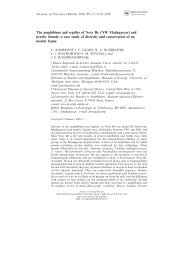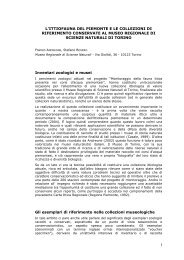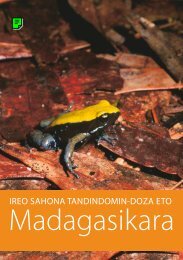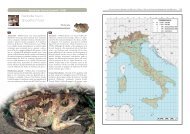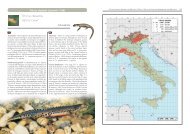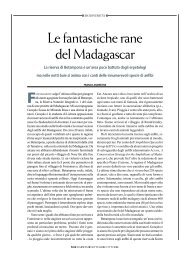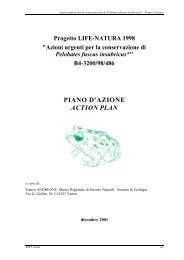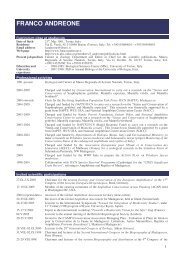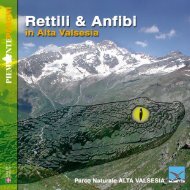Short Communications A possible attempt of ... - Franco Andreone
Short Communications A possible attempt of ... - Franco Andreone
Short Communications A possible attempt of ... - Franco Andreone
You also want an ePaper? Increase the reach of your titles
YUMPU automatically turns print PDFs into web optimized ePapers that Google loves.
<strong>Short</strong> <strong>Communications</strong>to eat hard-bodies lizards (CADLE 1999), andfor a single dissected museum specimen <strong>of</strong>Micropisthodon ochraceus which containedat least four snails (CADLE 2003). Liopholidophisrhadinaea is also known to prey uponamphibian eggs (CADLE 1996a). Ophiophagyis only reported for Mimophis mahfalensisand for Madagascarophis species (DOMER-GUE 1987, PRESTON-MAFHAM 1991).During our ongoing research work on theMadagascan herpet<strong>of</strong>auna we had the chanceto witness a singular behaviour regarding alittle known colubrid, Liophidium vaillanti.The observation occurred on 24 November2004 during a survey in the Isalo Massif,central-southern Madagascar (FianarantsoaProvince, Antsohy Fivondronona, RanohiraFiraisana), at a locality known as “Zahavola”(22°37.55’S; 45°21.50’E; altitude about 820m a.s.l). At the end <strong>of</strong> a day <strong>of</strong> survey workwe were just photographing a female Liophidiumvaillanti, whose presence had notyet been recorded for the Isalo Massif. Thissnake (823 mm total length) was handled forsome minutes with the purpose <strong>of</strong> taking photographs<strong>of</strong> dorsal pattern. At the same time,the voucher specimens <strong>of</strong> other preservedamphibians and reptiles were removed fromthe fixative solution (4 % formalin), and puton the ground, waiting to be labelled. One <strong>of</strong>these was an individual <strong>of</strong> another colubrid,a male Dromicodryas bernieri, <strong>of</strong> 710 mmtotal length. The live L. vaillanti and thefreshly fixed D. bernieri were at a certaintime quite close. The L. vaillanti immediatelynoticed the preserved snake and movedtowards it. Before we could react, it reachedit and grasped its head (Fig. 1), starting toswallow with repeated and alternating movements<strong>of</strong> the jaws. Since the D. bernieri wasfull <strong>of</strong> formalin we stopped the swallowing asquickly as <strong>possible</strong>, before its head was totallyswallowed. We documented this unusualbehaviour with some photographs and the L.vaillanti apparently was not at all disturbedby our activity and repeated flashes.Of course it is questionable whether theobserved behaviour is a real predation <strong>attempt</strong>or represents an aggressive answer toa stressed condition. We are led to sustainthe first hypothesis, since: (1) the L. vaillantispecimen was calm, and did not showany aggressive posture; (2) it did not limit itsattack to a bite, but it swallowed the other individual;(3) the L. vaillanti was much morerobust than its prey, having a maximum bodydiameter <strong>of</strong> about 20 mm versus 11 mm in D.bernieri. Besides this, since the D. bernieriwas immobile on the ground and unsuitablein term <strong>of</strong> smell after the formalin fixationwe are led to believe that the prey selectionin L. vaillanti is – at least partly - based uponvisual cues. Of course, further observationsare needed to confirm the regularity <strong>of</strong> thisophiophagy.In conclusion, we are led to interpret theapparent <strong>attempt</strong> <strong>of</strong> ophiophagy <strong>of</strong> L. vaillanti,given the harsh habitat conditions <strong>of</strong>the Isalo Massif (a very arid area) as an opportunisticpredation in a habitat where preyavailability is scanty, as was the case <strong>of</strong> thepredation <strong>of</strong> a large terrestrial boa (Acrantophisdumerilii) upon a giant cockroachdocumented for the same area (ANDREONE &MERCURIO 2005).AcknowledgementsThis research was made <strong>possible</strong> through anagreement with Malagasy institutions, and wassupported by the Nando Peretti Foundation, ConservationInternational, and the National AmphibianConservation Center.ReferencesANDREONE, F. & V. MERCURIO (2005): NaturalHistory. Acrantophis dumerilii (Dumeril’sGround Boa). Diet. – Herpetol. Rev., 36(2):185-186.CADLE, J.E. (1996a): Snakes <strong>of</strong> the genus Liopholidophis(Colubridae) from eastern Madagascar:New species, revisionary notes, and anestimate <strong>of</strong> phylogeny. – Bull. Mus. Comp.Zool., 154(5): 369-464.CADLE, J.E. (1996b): Snakes <strong>of</strong> the genus Geodipsas(Colubridae) from Madagascar, withdescriptions <strong>of</strong> new species and observationson natural history. – Bull. Mus. Comp. Zool.,182



